The Art Music Lounge
British composer Geoffrey Allen was born in 1927 and, as of this writing, is still going strong, living and working in Australia—a great big “up yours” to the Coronavirus!
Like so many modern composers, Allen’s music is bitonal leaning towards atonality, with sharply angular lines that clash between the soloist and accompanist, but as the first movement of the bassoon sonata shows, his music is also surprisingly lively and, oddly enough, has some jollity to it. Perhaps because of this, both performers here, Katherine Walpole and David Wickham, seem to be having a ball playing it, particularly the first movement. In short, although Allen’s compositional methods are not original, his style certainly is.
Yet oddly, his Outback Sketches for clarinet & piano is in an entirely different style, being tonal and lyrical although with some odd twists in the harmony here and there. This music’s title clearly gives it an Australian reference, but the music is so purely British that a Union Jack may as well pop up while the performers are playing it. Yet suddenly, at about the 2:10 mark in the first movement, Allen suddenly pulls the harmony away from the tonal center, not necessarily towards atonality but certainly towards remote keys, and from this point on in the first piece the listener is kept guessing as to where Allen will go next. Yet with the second and third movements, we’re back to placid, pastoral-sounding Brit music. Go figure.
The Pastorale for bassoon and piano lies somewhere between these two styles, so apparently Allen has a bit of a musical split personality…or perhaps he moved from a more bitonal, angular style (the bassoon sonata was written in 1964) to a more tonal, lyrical one (the Pastorale was written in 1998). Yet with the bassoon Sonatina (also 1998), Allen returns to his more bitonal style, albeit here combined with greater lyricism and less angularity.
The Fantasy Trio also combines lyricism with bitonality and is, in a way, the kin of York Bowen’s work of the same title. I found this to be, from a compositional standpoint, one of the most interesting works on the CD, as it creates an excellent mood without pandering too much to the “lovely classical music” lovers. Indeed, in this work it seemed to me that Allen had found the perfect “sweet spot” between mood and method; there’s a certain French sensibility about this piece that I liked very much. The two wind soloists, flute and clarinet, interact almost continuously and do so in very interesting ways, weaving their different lines around each other like vines on a trellis. Sometimes the clarinet reacts to what the flute is playing, sometimes vice versa, with the piano part almost ruminating as it subtly “grounds” the music. The piece thus creates a wonderful mood and ambience while still holding the listener’s attention every step of the way.
In the lively second movement, Allen again manages to write very jolly music within a bitonal framework, albeit not as angular as in the bassoon sonata. Both of our soloists, flautist Michael Waye and clarinetist Allan Meyer, really understand the nature of this score, and in this second movement pianist David Wickham has quite a bit more to do, his part here being more functional and less purely decorative. The third movement begins in a very tonal atmosphere and, like some of the previous works, is very lyrical and tonal. The fourth movement is both lyrical and a little bitonal, but panders more to those who like to hear Tunes in their music.
An odd collection, then, with some very good pieces, some weak ones, and a couple in the middle.
@divineartrecordingsgroup
A First Inversion Company
Registered Office:
176-178 Pontefract Road, Cudworth, Barnsley S72 8BE
+44 1226 596703
Fort Worth, TX 76110
+1.682.233.4978












